Exploring the Future of Music with AI - My Journey into Automatic Drum Accompaniment Generation
Introduction
As a technology enthusiast and music lover, I’ve always been intrigued by the idea of combining these two passions. The notion that artificial intelligence could assist in composing music—or even generate it autonomously—has captivated me for years. This curiosity led me to undertake a project that blends AI with music: Automatic Drum Accompaniment Generation from Melody.
In this blog post, I want to take you through my journey of creating a system that generates drum patterns for a given melody. This project challenged my technical skills and pushed the boundaries of what I believed AI could achieve in the realm of creativity.

Challenges
Music composition is not just about arranging notes; it’s about emotion, rhythm, and creativity. Drummers, for instance, do more than just keep time—they add flavor to the music, making it dynamic and engaging. The challenge I faced was teaching an AI to replicate this human creativity. How could I develop a system that not only understands the structure of music but also adds those subtle yet impactful drum fills and improvisations?
Approach
To address this challenge, I turned to the Transformer model—a neural network architecture that’s revolutionizing natural language processing and, increasingly, music generation. My goal was to create a system that could take a melody played by instruments like Piano, Guitar, Bass, and Strings, and generate an accompanying drum pattern.
The initial attempts were promising but not perfect. While the model could generate basic drum patterns that aligned with the melody, it struggled with the creative aspects—particularly with generating fills and improvisations that are so crucial in drumming.
Innovating with BERT-Inspired Models
Realizing that traditional Transformer models had limitations, I decided to experiment with a BERT-inspired approach. BERT, a model originally designed for natural language processing, excels at understanding context and filling in gaps. This inspired me to create a “novelty function” to detect and quantify the extent of improvisation in a drum pattern relative to its neighboring bars.
By training the model to recognize these moments of creativity and then using an in-filling technique, I was able to generate more dynamic and musically coherent drum patterns. This approach was key in moving beyond simple repetition and into the realm of true musical expression.
Evaluating Results
Evaluating AI-generated music is a complex task, combining both objective metrics and subjective opinions. Objectively, I measured the rhythmic consistency, distribution of drum hits, and other musical patterns. Subjectively, I sought feedback from musicians to assess the musicality of the generated patterns.
The results were encouraging. The model managed to maintain the groove while introducing subtle variations that made the drum patterns more engaging. While not perfect, the AI’s output was a significant step forward in achieving a balance between structure and creativity in music generation.
Reflection and Future Directions
This project has been a significant learning experience, showing me both the potential and the limitations of AI in music. It reinforced my belief that while AI can assist in the creative process, it still requires guidance and input from humans to reach its full potential.
Moving forward, I plan to explore more advanced data augmentation techniques and experiment with different architectures to improve the model’s ability to generate creative drum fills and improvisations. Additionally, I’m interested in expanding this work to other musical genres or even developing an interactive system that can collaborate with musicians in real-time.
Conclusion
In conclusion, my journey into automatic drum accompaniment generation has been a rewarding blend of creativity and technology. It’s a project that has pushed me to think differently about both music and AI, and I’m excited to see where this path leads in the future. If you’re interested in the technical details or want to try out the model for yourself, feel free to reach out—I’d love to share more about this exciting field of research.
Thank you for reading, and I hope this glimpse into my project has sparked your curiosity about the potential of AI in music. Stay tuned for more updates as I continue to explore the fascinating world of music generation.
You can find the thesis here.